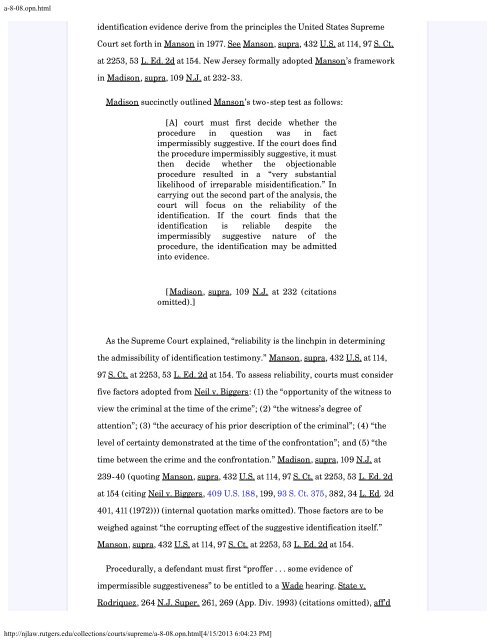State v. Henderson and the New Model Jury Charges - New Jersey ...
State v. Henderson and the New Model Jury Charges - New Jersey ...
State v. Henderson and the New Model Jury Charges - New Jersey ...
Create successful ePaper yourself
Turn your PDF publications into a flip-book with our unique Google optimized e-Paper software.
a-8-08.opn.html<br />
identification evidence derive from <strong>the</strong> principles <strong>the</strong> United <strong>State</strong>s Supreme<br />
Court set forth in Manson in 1977. See Manson, supra, 432 U.S. at 114, 97 S. Ct.<br />
at 2253, 53 L. Ed. 2d at 154. <strong>New</strong> <strong>Jersey</strong> formally adopted Manson’s framework<br />
in Madison, supra, 109 N.J. at 232-33.<br />
Madison succinctly outlined Manson’s two-step test as follows:<br />
[A] court must first decide whe<strong>the</strong>r <strong>the</strong><br />
procedure in question was in fact<br />
impermissibly suggestive. If <strong>the</strong> court does find<br />
<strong>the</strong> procedure impermissibly suggestive, it must<br />
<strong>the</strong>n decide whe<strong>the</strong>r <strong>the</strong> objectionable<br />
procedure resulted in a “very substantial<br />
likelihood of irreparable misidentification.” In<br />
carrying out <strong>the</strong> second part of <strong>the</strong> analysis, <strong>the</strong><br />
court will focus on <strong>the</strong> reliability of <strong>the</strong><br />
identification. If <strong>the</strong> court finds that <strong>the</strong><br />
identification is reliable despite <strong>the</strong><br />
impermissibly suggestive nature of <strong>the</strong><br />
procedure, <strong>the</strong> identification may be admitted<br />
into evidence.<br />
[Madison, supra, 109 N.J. at 232 (citations<br />
omitted).]<br />
As <strong>the</strong> Supreme Court explained, “reliability is <strong>the</strong> linchpin in determining<br />
<strong>the</strong> admissibility of identification testimony.” Manson, supra, 432 U.S. at 114,<br />
97 S. Ct. at 2253, 53 L. Ed. 2d at 154. To assess reliability, courts must consider<br />
five factors adopted from Neil v. Biggers: (1) <strong>the</strong> “opportunity of <strong>the</strong> witness to<br />
view <strong>the</strong> criminal at <strong>the</strong> time of <strong>the</strong> crime”; (2) “<strong>the</strong> witness’s degree of<br />
attention”; (3) “<strong>the</strong> accuracy of his prior description of <strong>the</strong> criminal”; (4) “<strong>the</strong><br />
level of certainty demonstrated at <strong>the</strong> time of <strong>the</strong> confrontation”; <strong>and</strong> (5) “<strong>the</strong><br />
time between <strong>the</strong> crime <strong>and</strong> <strong>the</strong> confrontation.” Madison, supra, 109 N.J. at<br />
239-40 (quoting Manson, supra, 432 U.S. at 114, 97 S. Ct. at 2253, 53 L. Ed. 2d<br />
at 154 (citing Neil v. Biggers, 409 U.S. 188, 199, 93 S. Ct. 375, 382, 34 L. Ed. 2d<br />
401, 411 (1972))) (internal quotation marks omitted). Those factors are to be<br />
weighed against “<strong>the</strong> corrupting effect of <strong>the</strong> suggestive identification itself.”<br />
Manson, supra, 432 U.S. at 114, 97 S. Ct. at 2253, 53 L. Ed. 2d at 154.<br />
Procedurally, a defendant must first “proffer . . . some evidence of<br />
impermissible suggestiveness” to be entitled to a Wade hearing. <strong>State</strong> v.<br />
Rodriquez, 264 N.J. Super. 261, 269 (App. Div. 1993) (citations omitted), aff’d<br />
http://njlaw.rutgers.edu/collections/courts/supreme/a-8-08.opn.html[4/15/2013 6:04:23 PM]
















